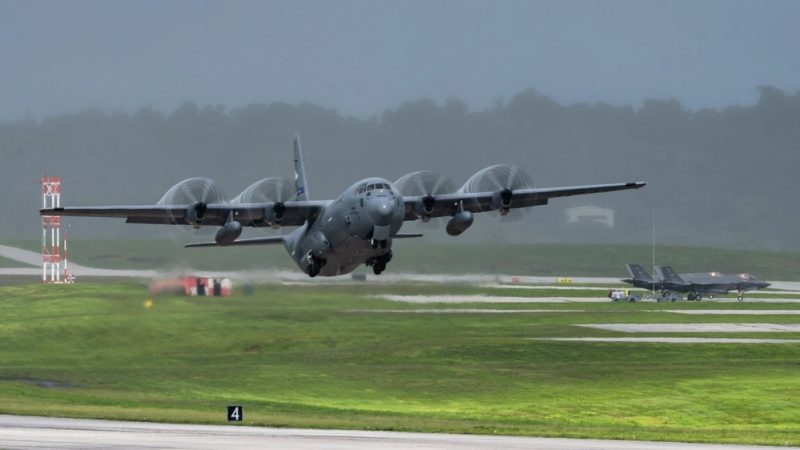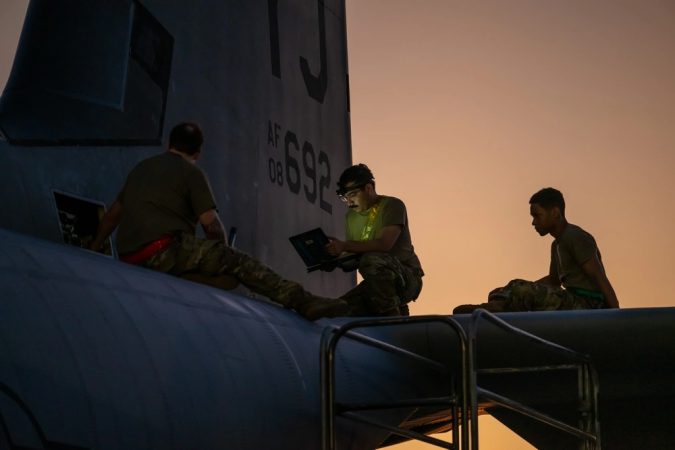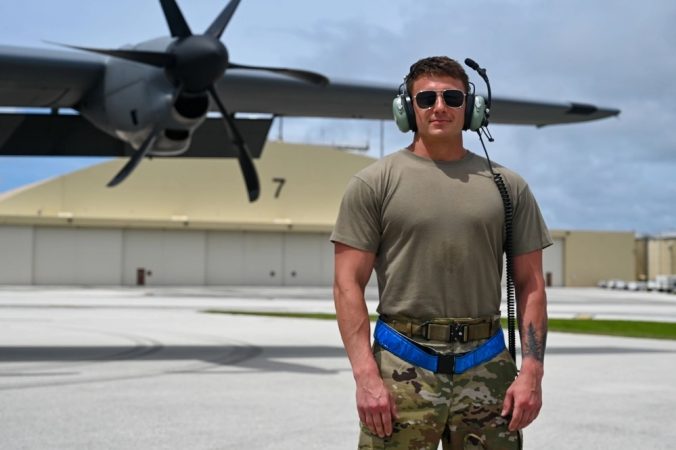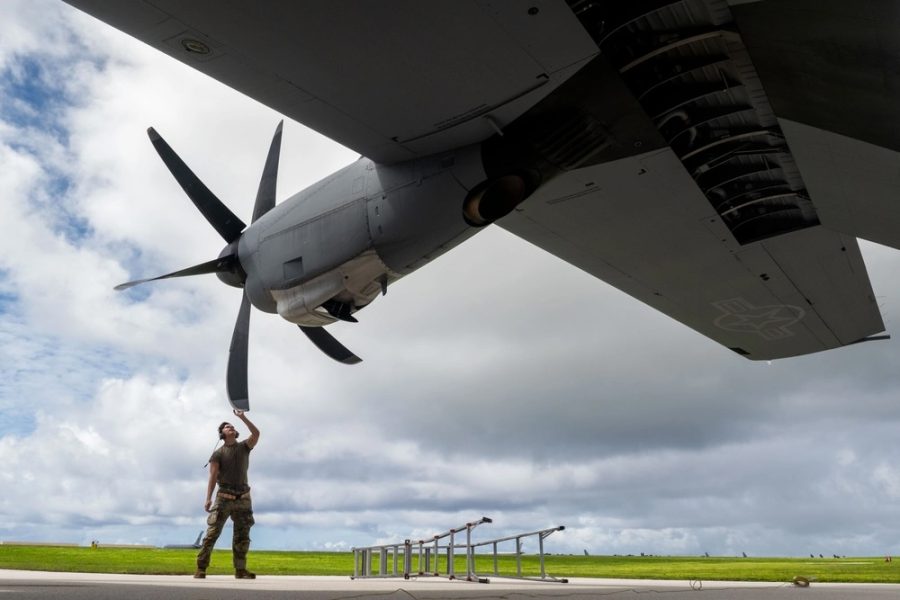ANDERSEN AIR FORCE BASE, Guam—When it comes to keeping aircraft safe, a little superstition can’t hurt. Case in point: Staff Sgt. Fredrick Crowl has a set routine every time he inspects a C-130 Hercules transport plane before flight.
“Every time we start the engines, I’ll start my prayers, and I’ll keep praying until the last engine starts up,” said the flying crew chief with the 19th Aircraft Maintenance Squadron. The prayers are for the aircraft, the crew, for anyone else on board, and for the mission.
“After that, it’s whatever I’m feeling,” Crowl said.
Once the engines are running, he says ‘amen,’ rubs the aircraft’s nose, hits the doors to its battery compartment and external power plug, then crouches down for a last peek up into the nose landing gear well.
“It’s like what you would do before a game,” he said. “You gotta show these girls love.”
Showing the C-130 “Herks” love is the name of the game for Crowl and the 60 or so other maintainers responsible for keeping six C-130 aircraft running smoothly for a month of hard flying over the Pacific.
Hailing from Dyess Air Force Base, Texas, and Little Rock Air Force Base, Ark., the maintainers are here for the Department-Level Exercise series, a sweeping new wargame where about 12,000 other Airmen and Guardians are practicing air combat, airlift, aerial refueling, aeromedical evacuation, and other missions across the Pacific alongside other U.S. armed forces and America’s foreign allies and partners, as they would if the U.S. ever goes to war with China.
The C-130 Hercules plays a key role moving small amounts of cargo over short distances, everything from potatoes to firetrucks.
“Flexible, rapid logistics, that’s what we do,” said Lt. Col. James Vanderneck, the head of a detachment of C-130s flying airlift missions between Guam and the nearby islands of Rota, Tinian, and Saipan. “If you want to take off and land within 30 minutes, the Herk is your aircraft.”

Each C-130 is made up of over 1 million parts, and when one fails, maintainers have to fix it. The work for the DLE started back at home station, where Airmen conducted exhaustive inspections of each aircraft to make sure it was ready for the big push, much like getting a car serviced before a cross-country road trip.
“We look for whether the aircraft has the legs to make the mission,” said Capt. Lynley Hummel, the officer in charge of maintenance for the C-130 element at Guam. “If you ever hear the term, ‘does it have the legs,’ we’re asking ‘does it have any structural health inspections due, or any hourly engine inspections?’ For missions like this where we’re out for an extended amount of time, we knock that out months in advance to make sure these tails are good to go.”
That applies to the maintainers too: every Airman going to Guam had to be up-to-date on their training, administrative paperwork, and medical requirements—even flu shots. Then there’s the packing list: maintenance squadrons keep pre-built lists of what they need for 30-, 60-, and 90-day operations, everything from tool boxes and spare parts to power generators and air conditioning carts to keep avionics cool in the tropical heat.
Once in Guam, the team split into two 12-hour shifts of about 30 maintainers each. The flying schedule identifies the tails they need to focus on each shift, starting with a pre-flight inspection. That involves checking over the hydraulics, engines, propellers, electronics, tire pressure, landing gear, and every other major component of the aircraft to make sure it is ready to fly.
The process takes one to five hours, depending on the number of maintainers available and how many issues come up. The work has to get done, even here, where the temperature pushes 90 degrees with high humidity and the only shade on the hardstand is under the aircraft’s wings.
“‘On the line, all the time,’ that’s our slogan,” Hummel said. “We’ll be here early in the morning before the planes launch, and then we’ll be here at night to catch them when they come back.”

Maintainers plug laptops into the aircraft, which can detects faults in its subsystems. The maintainers then troubleshoot to identify the exact problem and fix it. Sometimes the solution is simple: flip the switch a few times.
“This plane is very computerized, so there is a lot of ‘turn it off, turn it back on, reset circuit breakers,’ that sort of thing,” said Staff Sgt. Seth Lilly, a crew chief with the 19th Maintenance Squadron.
But some parts break and need replacing. While the maintainers bring spares to fix the most common breaks, some come by surprise, like when a cable that helps lower the cargo ramp to the ground broke on one of the C-130s early in the exercise.
When they don’t have the right spare part on hand, the maintainers must find it on Andersen or order it from another base: in this case Kadena Air Base, some 1,400 miles away. It could take a few days to arrive on base, and then it might take longer for the part to actually reach the C-130 maintainers since they are on temporary duty travel and not tied to a particular unit, Lilly explained.
That’s why patience is one of the tools in a maintainer’s kit. Waiting on parts takes time, and sometimes so does waiting for the air crew to show up and perform their pre-flight checks.
“Honestly, launching a plane is a lot of standing around,” Lilly said. “Because we are essentially waiting for the flight crew, and if there is an issue, we have to be here to fix it.”
The first person to respond to such issues is often the crew chief, a jack-of-all-trades who knows a bit about everything to do with the aircraft. If needed, the crew chief calls in a specialist in avionics, engines, electrical and environmental, or other systems.
But the C-130 excels at flying to austere runways without much maintenance support. Enter the flying crew chief, who goes through a special pipeline to prepare for being the only maintainer on hand if the plane breaks far from home.
“FCCs, they’re like the top dog, the diamond-level. You want to aim to be that guy,” Crowl said. “As an Airman, you look up to these guys, because they are never at home station: they are always talking about all these nice places they’re going, or even the bad places, but you’re with the boys, you know what I mean?”
Crowl set his sights on becoming an FCC early on in his career. He studied the thick maintenance technical orders “until I knew them like the back of my hand.” It paid off, and for the past four years it’s been “the most rewarding job I’ve ever had.
“All your hard work pays off,” he said. “You can green up the aircraft and make the mission happen, especially as an FCC.”

Crowl’s fellow FCC, Staff Sgt. Kyle Mack, shared his opinion.
“It’s really rewarding when we fix these planes,” he said. “You see that pilot give you a nice thumbs-up like ‘yeah we’re ready, let’s go.’”
Mack, Crowl, and Lilly were excited to be in Guam for the DLE, where they could see how their efforts help keep the larger Air Force in action. Together, they have about 19 years of maintenance experience, and most of their fellow C-130 knuckle-busters on Guam for the DLE are similarly well-seasoned.
“Everyone out here is pretty well-rounded,” Mack said. “We try to bring out guys that have a good amount of experience.”
But holding onto such experienced noncommissioned officers is not always easy, said Hummel.
“A lot of our NCO corps are either getting out of the Air Force altogether or are getting pulled for special duties, and that takes away a critical portion of what makes maintenance successful—that leadership on the flight line,” she explained. “We need that experience.”
Hummel is not the only one concerned. In a 2024 essay for War On the Rocks, another crew chief, Senior Master Sgt. Joshua Morales, warned of an experience shortage in the maintenance corps, a problem which he said is just as alarming as the Air Force’s pilot experience shortage.
“Failure to act decisively on this issue could result in a fleet less prepared for the demands of modern warfare, potentially eroding the United States’ long-standing dominance of the skies,” he wrote.
For now though, the maintainers from Dyess and Little Rock are doing what they do best.
“We get a lot of pride out of fixing aircraft and seeing them go up, so we like being out here,” Lilly said. “It’s 12-hour days, but I don’t know, it’s worth it.”


